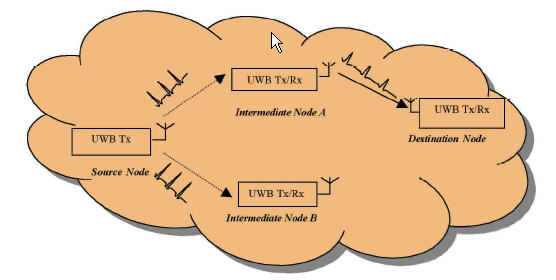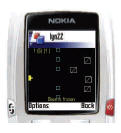|
The objective of this research program is
to devise and experiment techniques with mobile network and
wireless technologies, protocols and applications. The
research activities of the group include WPAN technologies
(Bluetooth and UWB), Mobile ad hoc network (MANET), multihop
cellular networks and the current new interests in mobile game
development.
WPAN Technologies (Bluetooth and UWB)
Introduction
Wireless
personal area networks (WPANs) are short-distance, low-power
networks that connect devices carried by users to other
devices that are used within a personal space. A personal
space is an area that corresponds to a person’s natural
interactive space, e.g. the reach of a hand or audible
distance of a voice, which typically has a distance of up to
10 meters. WPANs aims to improve the living and working
environment of a person by allowing the variety of personal
communication devices such as personal digital assistants (PDAs),
hand phones, web tablets, and wearable devices to communicate
and interoperate with one another. Among the leading WPAN
technologies currently considered by the IEEE 802.15 Working
Group for standardization include Bluetooth and ultra-wideband
(UWB) technology.
Bluetooth
Development of Bluetooth applications is an
area which NTRC has been actively pursuing. With keen
technical and development support from leading Bluetooth
solution providers such as Ericsson and CSR (Cambridge Silicon
Radio), an application development team under the supervision
of Assoc Prof Tong Yit Chow has developed a number of working
prototypes for such devices as Bluetooth-enabled GSM/GPSR
smart phones, Bluetooth LAN access point, wireless lab
equipment, wireless location/product directory service,
automated utility (e.g. electricity, gas, fuel, water) meter
reading, and surveillance cams.

Figure 3.1: Example of a developed WPAN
application: A Bluetooth-enabled wireless location/product
directory service.
UWB Ad-Hoc Network
Recently, work has also been initiated to
develop a generic wireless system based on UWB to support
pervasive computing and communication in a home/office
environment. At present, efforts are focused on protocol stack
and embedded OS development for the generic system.
Nomadic WPAN applications that exploit the key advantages of
UWB, including high data rate, robust multipath performance as
well as high-accuracy indoor localization, will be developed
to enable intercommunication and sharing of multimedia content
and broadband services among a variety of UWB-enabled devices
anywhere in and around the home/office environment.
In a UWB ad hoc network, several piconets
(a piconet is a collection of several wireless (personal)
devices that can communicate among devices) are formed in an
ad hoc way without any infrastructure assistance. All the
piconets are allowed to communicate with one another. The key
issues to deploy a UWB ad hoc network includes:
In the development of UWB protocol stack
related to network layer in this project, we are focusing on
the technique to form a piconet more efficiently and develop
an effective routing protocol to forward packets from the
source to the destination.
The formation of piconets will be based on
a cluster-based ad hoc technique because clusterbased ad hoc
is able to i) facilitate the wireless transmission management
among devices; ii) provide a natural virtual backbone for
inter-cluster routing; and iii) extract network information
and require less information exchange among devices. The other
research focus is to develop a routing protocol for use in UWB
ad hoc network. We concentrate on the performance of the
routing protocol to support pure IP ‘best effort’ traffic or
data services with different quality-of-service requirement.
It is possible that with multi-hop routing, UWB transmitters
could reduce their transmit power emissions and thus allow
more devices to be operated at the same time.
Currently, we are implementing some basic
functions of ad hoc network using UWB radio technology as
shown in the Figure 3.2. The source of the UWB transmitter
will send the message to the destination via the one of the
closest intermediate nodes. Some of the techniques, like
packet forwarding and path selection strategies, are awaited
to be realised. The idea of this project could be considered
to apply for the future UWB ad hoc network.

Figure 3.2: UWBRT System – routing
strategy
Multihop Cellular Networks
Multihop cellular networks have been
proposed as an extension to the conventional single-hop
cellular network by combining the infrastructure that is used
in ad hoc networks as shown in the Figure 3.3. Due to the
potential of the multihop relaying to enhance coverage,
capacity and flexibility, multihop cellular networks have been
attracting considerable attention for future 3G and beyond
systems. This network architecture provides future cellular
systems with the possibility of peer-to-peer (mobile to
mobile) communication as well as communication relayed
through other fixed and/or mobile terminals, unlike
present-day centralized cellular networks where every
communication has to go through the central base station.
Due to high power level difference between
transmit and receive signals, simultaneous transmission and
reception in the same frequency band is not practical. Thus,
WCDMA-TDD mode transmission is a suitable duplexing mode for
the multihop cellular network. Moreover, the multihop
transmission means that it will cost more radio resources for
just one transmission. And different selection algorithm of
the relay station could give different performance to the
overall system. Thus, in order to meet the flexible
requirement for the next generation cellular services, our
project consists of the following tasks:
-
Dynamically allocate the WCDMA-TDD radio
resource among mobile users in the service area. The
relationship among coverage area, position of the relay
station, different power control schemes and the system
capacity are studied to achieve the best compromise
-
New multihop routing protocol that
considers the specifics of the cellular environment,
including the presence of base stations, asymmetric traffic
(uplink versa downlink traffic), hop-point area and
heterogeneous traffic types in cellular networks, will be
investigated. Currently, the system model for the first task
has already been built. Based on this model, both simulation
and analysis results are accomplished. We are now studying
different power control algorithms to achieve the best
performance.

Figure 3.3: Multihop Cellular Network
Architecture.
Mobile ad hoc network (MANET)
Introduction of MANET
The proliferation of wireless communication
and mobile devices in recent years has opened the door to
research on self-organizing networks that do not require a
pre-established infrastructure as shown in Figure 3.4. Those
spontaneous networks, normally called ad hoc networks, provide
mobile users with ubiquitous communication capacity and
information access regardless of the location.
The most important characteristic of such
network is the independence of any fixed infrastructure or
centralized administration. An ad hoc network is capable of
operating autonomously and is completely self-organizing and
self-configuring. Therefore, it can be rapid and easily
deployed.
Another important property of an ad hoc
network is the multihop capability. Unlike the cellular
networks, which are single-hop wireless networks, an ad hoc
network does not guarantee that a mobile node can directly
communicate with its destinations all the time. A mobile node,
which lies outside the transmission range of its specific
destination, would need to relay its information flow through
other mobile nodes. This implies that mobile nodes in ad hoc
networks bear routing functionality so that they can act both
as routers and hosts.
An ad hoc network can be deployed in an
area where supports for mobile communication is not available,
probably due to high deployment costs or disaster destruction.
The typical application of ad hoc networks includes battle
field communication, emergency relief and extension of the
coverage area of cellular networks.
Project Description
It is a big research challenge to design
suitable protocols especially at the MAC and the network layer
that can cope well with high mobility, limited bandwidth and
power scarcity of a typical ad hoc network. Our research
focuses on designing an energy-efficient routing protocol.
Dynamic routing is an important behavior of an ad hoc network
so that energy metrics should be taken into consideration for
the guarantee of the routing performance. The early “death” of
some mobile nodes due to energy depletion may cause severe
problems, such as network partition and communication
interruption. The main objective of our current research topic
is to maximally balance the energy consumption of mobile nodes
in a network in order to prolong the whole network lifetime.
Current Progress
We have designed a routing algorithm named
Energy Balancing Hybrid Routing (EBHR) and tested its
performance with network simulator (ns2). In comparison with
the typical dynamic routing protocol, such as dynamic source
routing (DSR) and ad-hoc on-demand distance vector routing (AODV),
and other energy balancing routing protocols, such as local
energy-aware routing (LEAR) and time delay on-demand routing (TDOR).
It was found that EBHR can actually achieve better performance
in terms of energy balancing. At the same time, EBHR has
satisfactory packet delivery ratio and end-to-end delay, which
are important parameters for a routing protocol and are
therefore comparable to those of DSR.

Figure 3.4: MANET Architecture.
System Performance Evaluation of TETRA/TETRAPOL
in a Wireless Environment via Computer Simulation
TETRA/TETRAPOL is a digital, trunked
radio standard for the most demanding professional mobile
radio users. The objective of this research project is to
study the system performance of a general trunked radio
system and a TETRA/TETRAPOL system in a Wireless Environment
via Computer Simulation using OPNET simulation tool. This
project is collaborated between NTRC and CET. The major
tasks involve in this project include simulation modelling,
performance evaluation criteria and performance analysis.
A number of simulation models and
functions have been implemented into OPNET according to the
TETRA/TETRAPOL specifications, including channel models,
transceiver characteristics, multiple access protocols,
mobility models, traffic models for voice and data, handoff
mechanism and operation of system. Evaluation of TETRA/TETRAPOL
network will be performed in terms of linklevel and
system-level performances. The link-level performance
involves the performance of an individual mobile station
(MS) through transmission, propagation and reception.
Simulation results for the link-level performance are based
on bit error rate (BER) and frame error rate (FER) with
different signal-to-noise ratio. The system-level
performance simulates the link performance of all MS's in
the TETRA/TETRAPOL system. The entire TETRA/TETRAPOL
operations including mobility, handoff, traffic generation
are evaluated in the OPNET simulation. Results are analyzed
using performance metrics such as throughput, handoff rate,
voice call blocking rate, packet delay and channel access
delay.

Figure
3.5: System performance evaluation of TETRA/TETRAPOL in a
wireless environment via computer simulation.
Mobile Game Development
Mobile gaming is the next in-thing of the
future. According to market research reports by market
research firms, the global games industry was worth US$31
billion for year 2003. For handheld and mobile platforms
markets alone, it formed about 15.5% of the revenue in the
global gaming industry. Last year, the Asia-Pacific region
(excluding Japan) contributed 22 per cent of the global
revenue from mobile gaming and predicted that in 2006, the
figure will rise to 41 per cent.
In Singapore, established mobile gaming
platforms such as handheld Nintendo games and Java enabled
mobile phones have a loyal following. According to a Nokia
spokesman, some of the more popular downloaded Java games for
mobile phones include Puzzle Bobble, Mahjong 13 and Big 2. The
spokesman also added that Java game downloads are increasing,
especially when phones with colour screens are becoming more
popular. These phones allow more fanciful games to be
developed. More and more developers are creating Java games
too.
In the light of these developments,
Professor Tony Woo, Vice-President of Research, has initiated
the mobile game projects. These projects are funded by the
research office and supported by the GameLab of SCE. The
objective is to provide students with a common interest in
mobile gaming to work together and create mobile games. The
initiative had selected 6 undergraduate students from school
of EEE and SCE to work on this one-year project. In addition,
some undergraduate students under Dr Peter H J Chong had also
participated in the development work. The students designed
the game with their own ideas and implemented through Java
(J2ME) and C++ programming language. Following describes some
of the games being developed and implement on the
Bluetooth-enabled phone for multi-play gaming.
 |
Satellite War Game Multi-Gaming
Satellite is a variant of the classic
Pong set in space where bored satellite operators move
around in circular orbits and bounce radio waves between
their satellites. Players move in circular paths and vary
movement by using the Up, Down, Left and Right keys.
Players can start a game server on their own phone and
wait for nearby devices to connect to it, or alternately
search for active game servers running in the vicinity and
join them. There are a couple of game modes available–
classic, greedy and practice. |
| |
|
 |
Virtual World Game
VirtualFascinated is a multi-user game
for Pocket PC, it is modeled as an interactive virtual
world that allows players to join in various activities,
share information, make friends and raise a virtual pet.
The difficulty of the game is increased along the course
of the game. Furthermore, as the virtual pet grows, more
interactive functions will be activated. |
| |
|
 |
Shooting block Game
The base stationed on the left of the
mobile screen will fire out bullets to hit the coming
blocks entering on the right hand side of the screen.
Destroying these blocks will help the players to earn
points. However the blocks will increase with difficulty
level and if the blocks of lower level are not destroyed,
they will increase in both strength and speed. |
Ongoing Research Project
| Project
Title |
Principal
Investigator |
|
Demonstration of UWB Ad Hoc – A Promising Technology
|
Peter
H J Chong |
|
Simulation Study of Tetrapol Trunked Systems |
Peter
H J Chong |
|
Mobile Game Development over Bluetooth |
Peter
H J Chong |
|